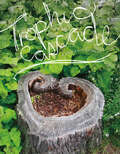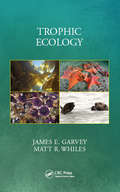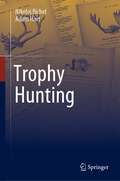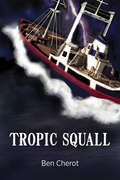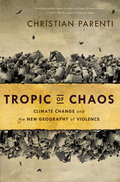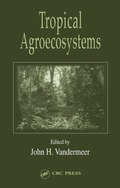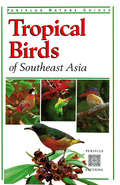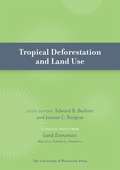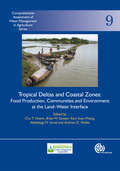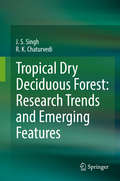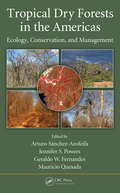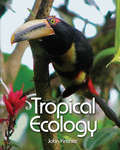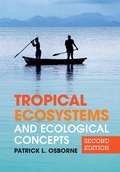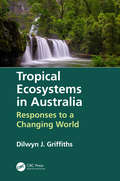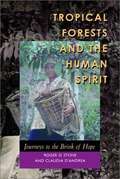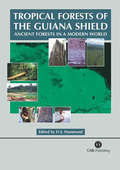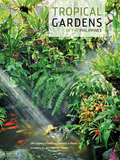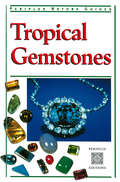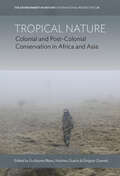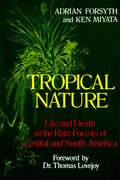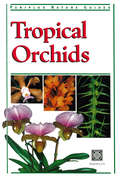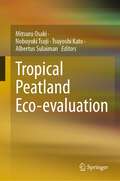- Table View
- List View
Trophic Cascade (Wesleyan Poetry Ser.)
by Camille T. Dungy&“A soulful reckoning for our twenty-first century, held in focus through echoes of the past and future, but always firmly rooted in now.&” —Yusef Komunyakaa, Pulitzer Prize-winning poet Winner of the Colorado Book Award in Poetry (2018) In this fourth book in a series of award-winning survival narratives, Dungy writes positioned at a fulcrum, bringing a new life into the world even as her elders are passing on. In a time of massive environmental degradation, violence and abuse of power, a world in which we all must survive, these poems resonate within and beyond the scope of the human realms, delicately balancing between conflicting loci of attention. Dwelling between vibrancy and its opposite, Dungy writes in a single poem about a mother, a daughter, Smokin&’ Joe Frazier, brittle stars, giant boulders, and a dead blue whale. These poems are written in the face of despair to hold an impossible love and a commitment to hope. A readers companion will be available at wesleyan.edu/wespress/readerscompanions. &“Dungy asks how we can survive despair and finds her answers close to the earth.&” —Diana Whitney, The Kenyon Review &“Trophic Cascade frequently bears witness—to violence, to loss, to environmental degradation—but for Dungy, witnessing entails hope.&” —Julie Swarstad Johnson, Harvard Review Online &“Tension. Simmering. Beneath her matter-of-fact, easy-going, sit-yourself-down, let-me-tell-it-like-it-is clarifying. And her power we take deadly seriously.&” —Matt Sutherland, Foreword Reviews &“[Trophic Cascade] asks us, in spite of the pain or difficulty of being human today, to find joy and vibrancy in our experiences.&” —Elizabeth Flock, PBS Newshour
Trophic Ecology
by James E. Garvey Matt WhilesThis book is a bridge between ecological paradigms – organismal/community approaches to food web dynamics and ecosystem-level approaches to production. The unification of organismal, community, and ecosystem approaches in ecology is emerging due to the growing availability of new techniques for assessing trophic interactions and their implications for ecosystems. Trophic Ecology is a formal text for both newcomers to the discipline as well as seasoned professionals looking for new ideas and refreshers on old topics. A wide range of topics are explained including autotrophy, heterotrophy, omnivory, decomposition, foraging behavior and theory, trophic cascades, bioenergetics, and production. The audience is upper-level undergraduate students and entry-level graduate students interested in autecological, organismal approaches to ecology, community and ecosystem ecology. It is also a reference text for instructors teaching upper-division courses, providing examples from the literature, quantitative approaches to teach, and new hypotheses yet to be fully tested by ecologists.
Trophy Hunting
by Adam Hart Nikolaj BichelThis book gets to the heart of trophy hunting, unpacking and explaining its multiple facets and controversies, and exploring why it divides environmentalists, the hunting community, and the public. Bichel and Hart provide the first interdisciplinary and comprehensive approach to the study of trophy hunting, investigating the history of trophy hunting, and delving into the background, identity and motivation of trophy hunters. They also explore the role of social media and anthropomorphism in shaping trophy hunting discourse, as well as the viability of trophy hunting as a wildlife management tool, the ideals of fair chase and sportsmanship, and what hunting trophies are, both literally and in terms of their symbolic value to hunters and non-hunters. The analyses and discussions are underpinned by a consideration of the complex moral and practical conflicts between animal rights and conservation paradigms. This book appeals to scholars in environmental philosophy, conservation and environmental studies, as well as hunters, hunting opponents, wildlife management practitioners, and policymakers, and anyone with a broad interest in human–wildlife relations.
Tropic Squall
by Ben CherotIn August of 1992, one of the small tramp ships out of Miami that trade in the remote ports of the Caribbean is unaware it steams in the path of chaos---a hurricane named Andrew. The seafaring stalwarts who crew her ascribe to different ethics than those on land---they are a diverse group who live in a cruel environment, frightening while gratifying, with values derived from experiences unique to their world, while in both harmony and conflict with nature and fellow humans. Survival is their strongest ethic. The ship's first officer, Hogue, a mature and weather-beaten product of the West Virginia coal fields, has long aspired to become a master mariner and captain a ship, requiring he defeat a lust for booze. During the three-day voyage to Haiti, Hogue seduces Cora, a female passenger, which develops into a romance. But the battering of a hurricane threatens the existence of both.
Tropic of Chaos: Climate Changes and the New Geography of Violence
by Christian ParentiFrom Africa to Asia and Latin America, the era of climate wars has begun. Extreme weather is breeding banditry, humanitarian crisis, and state failure. In Tropic of Chaos, investigative journalist Christian Parenti travels along the front lines of this gathering catastrophe--the belt of economically and politically battered postcolonial nations and war zones girding the planet's midlatitudes. Here he finds failed states amid climatic disasters. But he also reveals the unsettling presence of Western military forces and explains how they see an opportunity in the crisis to prepare for open-ended global counterinsurgency. Parenti argues that this incipient "climate fascism"--a political hardening of wealthy states-- is bound to fail. The struggling states of the developing world cannot be allowed to collapse, as they will take other nations down as well. Instead, we must work to meet the challenge of climate-driven violence with a very different set of sustainable economic and development policies.
Tropical Agroecosystems (Advances in Agroecology)
by John H. VandermeerTropical areas present ecological, cultural, and political problems that demand analysis that is distinct from general ecological analysis. The tropical environment is special in many ways, from the lack of a biological down season (winter), to generally poor soil conditions, to a reliance on traditional methods of agriculture in an undeveloped society. Presenting a broad range of approaches to agroecosystem analysis, this book addresses specific ecological issues associated with agricultural production, examines two case studies of agricultural transformation and its effect on biodiversity, and discusses key landscape relationships between agroecosystems, wildlife, and human disease.
Tropical Birds of Southeast Asia
by Morten StrangeThis handy field guide is an excellent introduction to the fantastic array of birds found in Southeast Asia. This selection features 96 typical species and clearly describes their special characteristics. Many are easy-to-find birds adapted to living around cities and towns, while others can be seen in nature reserves. Illustrated with over 100 beautiful color photographs, showing the birds in their natural habitats, this book will delight both keen bird watchers and beginners alike. Over 100 full-color photographs Informative text Scientific and common names listed
Tropical Cyclone Activity over the North Indian Ocean
by L. S. Rathore M. Mohapatra B. K. BandyopadhyayThis book deals primarily with understanding, monitoring and prediction of Tropical Cyclones (TCs) over the North Indian Ocean (NIO). There is special emphasis on TC genesis, intensification, movement and associated adverse weather like heavy rainfall and gale winds. It highlights the current state of research on TCs over the NIO and recent improvements in early warning systems due to advances in observational, analytical and numerical weather prediction techniques. The chapters in the book are authored by leading experts from research and operational environments. The chapters presented in the book intend to stimulate thinking and hence further research in the field of TCs, especially over the NIO region. They provide high quality reference material for all experts working in the field of TC related disaster management. This book is relevant to TC forecasters and researchers, managers, policy makers, graduate and undergraduate students.
Tropical Deforestation and Land Use
by Edward B. BarbierCountry case studies investigate key factors that influence the economics of tropical deforestation and land use. Articles illustrate how innovative economic models can be used effectively to investigate a range of important influences on tropical land use changes in a variety of representative developing countries. The countries covered are: Brazil, India, Malaysia, Panama, the Philippines, Thailand, and Uganda.
Tropical Deltas and Coastal Zones: Food Production, Communities and Environment at the Land–Water Interface
by Chu T. Hoanh Brian W. Szuster Kam Suan-Pheng Abdelbagi M. Ismail Andrew D. NobleFocusing on the developing countries of Asia, Africa and South America, chapters of the book explore the diverse livelihoods of people in these areas and the impact of land-water management on the environment. New techniques and methodologies are explored in land and water management to try and solve the conflicts between rice-based agriculture, aquaculture, fisheries and the environment in tropical delta regions.
Tropical Dry Deciduous Forest: Research Trends and Emerging Features
by J. S. Singh R. K ChaturvediTropical dry deciduous forests (TDFs) can be found in severe and extremely variable climates characterized by low annual rainfall, 5-6 dry months within the annual cycle, and nutrient-poor soil. Several terms have been used for this vegetation type such as seasonally dry tropical forest (SDTF), tropical dry deciduous forest, monsoon forest, caatinga, cuabal, etc. More than any other factor, the lack of precipitation during a prolonged portion of the year is what produces true dry forest, an ecosystem type characterized by plants and animals with specific adaptations to survive the long dry season. Deciduousness is the single most important adaptation among plants to the extended droughts. Most of the trees drop their leaves after the rains end, and essentially halt photosynthesis, as they would otherwise be unable to survive the water loss during the dry season. TDFs are subject to intensive anthropogenic disturbances and are among the most at-risk ecosystems in the world. In order to assess the conservation status of this forest type, information is required on its distribution pattern, climate, the structure and functional traits of its vegetation, phenology, strategies for coping with drought and nutrient poverty, and disturbances and their effects. In this book, we review important studies on TDFs around the globe, particularly those in the northern dry deciduous forests of India. We put forward the claim that those TDFs that experience drought and arise on nutrient-poor sites feature adaptations such as deciduousness, as well as a variety of nutrient conservation strategies. They also experience biotic disturbances, which can result in fragmentation and ecosystem conversion, and therefore exhibit changes in biomass, productivity, and soil microbial biomass, etc.
Tropical Dry Forests in the Americas: Ecology, Conservation, and Management
by Jennifer S. Powers Geraldo W. Fernandes Mauricio Quesada Arturo Sánchez-AzofeifaUnder threat from natural and human disturbance, tropical dry forests are the most endangered ecosystem in the tropics, yet they rarely receive the scientific or conservation attention they deserve. In a comprehensive overview, Tropical Dry Forests in the Americas: Ecology, Conservation, and Management examines new approaches for data sampling and
Tropical Ecology
by John KricherThis full-color illustrated textbook offers the first comprehensive introduction to all major aspects of tropical ecology. It explains why the world's tropical rain forests are so universally rich in species, what factors may contribute to high species richness, how nutrient cycles affect rain forest ecology, and how ecologists investigate the complex interrelationships among flora and fauna. It covers tropical montane ecology, riverine ecosystems, savanna, dry forest--and more.Tropical Ecology begins with a historical overview followed by a sweeping discussion of biogeography and evolution, and then introduces students to the unique and complex structure of tropical rain forests. Other topics include the processes that influence everything from species richness to rates of photosynthesis: how global climate change may affect rain forest characteristics and function; how fragmentation of ecosystems affects species richness and ecological processes; human ecology in the tropics; biodiversity; and conservation of tropical ecosystems and species.Drawing on real-world examples taken from actual research, Tropical Ecology is the best textbook on the subject for advanced undergraduates and graduate students. Offers the first comprehensive introduction to tropical ecology Describes all the major kinds of tropical terrestrial ecosystems Explains species diversity, evolutionary processes, and coevolutionary interactions Features numerous color illustrations and examples from actual research Covers global warming, deforestation, reforestation, fragmentation, and conservation The essential textbook for advanced undergraduates and graduate students Suitable for courses with a field component
Tropical Ecosystems and Ecological Concepts
by Patrick OsborneTropical habitats cover over one third of the Earth's terrestrial surface and harbor much of its biodiversity, with many areas rich in endemic species. However, these ecosystems are under significant and growing threat from issues such as deforestation, land degradation and ocean acidification. This introductory textbook provides a comprehensive guide to the major tropical biomes. It is unique in its balanced coverage of both aquatic and terrestrial systems and in its international scope. Each chapter is built around a particular tropical ecosystem, with descriptive case studies providing a framework around which ecological concepts and applied ecological topics are presented. This second edition has been thoroughly updated to reflect recent advances in the field and includes a greater focus on the impact of global climate change. The text is supported throughout by boxes containing supplementary material and is illustrated with over 200 clear, simple line diagrams, maps and photographs.
Tropical Ecosystems in Australia: Responses to a Changing World
by Dilwyn GriffithsOver the last century, the world has lived through changes more rapid than those experienced at any other time in human history, leading to pressing environmental problems and demands on the world’s finite resources. Nowhere is this more evident than across the world’s warm belt; a region likely to have the greatest problems and which is home to some of the world’s most disadvantaged people. This book reviews aspects of the biology of tropical ecosystems of northern Australia, as they have been affected by climatic, social and land-use changes. Tropical Australia can be regarded as a microcosm of the world’s tropics and as such, shares with other tropical regions many of the conflicts between various forms of development and environmental considerations. The book draws on a wide range of case studies of tropical Australian ecosystems ranging from coastal coral reefs and mangroves, known to be among the most vulnerable to the effects of the imposed changes, to cropping and pasture lands which, under careful management, have the potential remain as productive and sustainable agricultural or forestry ecosystems. Expert author Dilwyn Griffiths -emphasizes the importance of maintaining an active program for the establishment and management of national parks and environmental reserves -describes the effects of mining and other forms of industrial and urban development with particular reference to mine-site rehabilitation - explores problems relating to the restoration of marginally uneconomic farming land as alternative forms of land-use such as carbon farming through photosynthetically-driven carbon sequestration. This accessible reference work should find a place in educational libraries at all levels and become an essential resource for environmentalists and anyone with interests in various forms of land-use and development.
Tropical Flowers
by William WarrenLearn all about beautiful tropical flowers with this useful and portable reference book. This handy pocket guide introduces 55 plant species commonly found in the Tropics. Each exotic bloom is described in detail, its history of origination discussed and gardening tips are given. Illustrated with over 120 beautiful color photographs, this book contains a wealth of botanical details, as well as fascinating information on the cultural uses of flowers. A "must" for gardeners and non-gardeners alike Periplus Handy Pocket Guides are practical field guides, useful for identifying various natural objects ranging from plants and animals to gemstones and seashells. Each page of each title throughout the series is filled with clear, precise photographs and informative text. Scientific and local language names are given.
Tropical Forests and the Human Spirit: Journeys to the Brink of Hope
by Roger D. Stone Claudia D'AndreaAn overview of the international events which in the last thirty years have caused the rapid destruction of the world's tropical forests and an argument for the case that the best way to conserve remaining forests is through the management of the land by the indigenous people who depend on the forest for their survival.
Tropical Forests of the Guiana Shield: Ancient Forests in a Modern World
by D. S. HammondThe Guiana Shield is an ancient geological formation located in the northern part of South America, covering an area of 1 million square kilometers. Despite its hostile environment, it is home to many unusual and highly specialized plants and animals, which constitute a rich area of biodiversity. Chapters in this book include hydrology, nutrient cycling, forest phenology, insect-plant interactions, forest microclimate, plant distributions, forest dynamics and conservation and management of flora and fauna. It provides a comprehensive and detailed review of the ecology, biology and natural history of the forests of the area.
Tropical Gardens of the Philippines
by Elizabeth Reyes Luca Invernizzi Tettoni Lily Gamboa O'BoyleOffering a rare glimpse into some of the most beautiful tropical gardens in the world, Tropical Gardens of the Philippines presents spectacular contemporary gardens--large and small--situated in and around the Metropolitan Manila area and the nearby provinces of Laguna, Batangas and Tagaytay. This gorgeous volume introduces a contemporary gardening style that has been evolving in the Philippines over the past decade as talented designers have come into their own--not to mention all the talented homeowners who are making this happen. All are finding their own original niches in attempting to define a unique tropical gardening style.
Tropical Gemstones
by Carol ClarkGemstones, both mythical and real, are deeply embedded in the arts, religions and cultures of Southeast Asia.<P><P> This Periplus Nature Guide provides an excellent introduction to the full range of superb gemstones mined and processed in the region, their physical characteristics, historical importance and countries of origin. Stunning color photographs and informative text by noted writer on gemstones, Carol Clark, will delight both gem collectors and lovers of fine jewelery alike.
Tropical Nature: Colonial and Post-Colonial Conservation in Africa and Asia (Environment in History: International Perspectives)
by Guillaume Blanc, Mathieu Guérin and Grégory QuenetAcross Africa and South-East Asia, the impulse to protect nature often dovetails with the domination of local people. From mass displacement to severe restrictions on land use and daily acts of violence, conservation work risks reproducing Eurocentric modes of colonialism and worsening the effects of the climate crisis. In this insightful and wide-ranging study of the colonial history of conservation, Tropical Nature seeks to provide a much-needed history of the Global South from its own perspective. Comparing case studies ranging from Ali Bongo’s Gabon, to the postcolonial African itinerary of the agronomist Arthur Bunting, this volume advances a “small-scale global history” that deciphers the relations binding human societies to the non-human world.
Tropical Nature: Life and Death in the Rain Forests of Central and (Zona Tropical Publications)
by Adrian Forsyth Ken MiyataSeventeen marvelous essays introducing the habitats, ecology, plants, and animals of the Central and South American rainforest.A lively, lucid portrait of the tropics as seen by two uncommonly observant and thoughtful field biologists. Its seventeen marvelous essays introduce the habitats, ecology, plants, and animals of the Central and South American rainforest. Includes a lengthy appendix of practical advice for the tropical traveler.
Tropical Orchids
by David P. BanksThis handy field guide provides an excellent introduction to over 120 exotic orchid species found in Southeast Asia, many unique to the region. Included are full-color photographs of their extraordinarily beautiful blooms and a wealth of expert botanical information. The photographs and text by David Banks, noted authority on tropical orchids, will delight orchid lovers the world over.
Tropical Pacific Island Environments
by Chirstopher S. Lobban Maria Schefter Rick L. CastroDiscusses the ecosystems of the islands of Oceania. Important themes in the book are the connection of ecological principles with local issues and experience, issues of sustainability, the validation of traditional knowledge, and examination of the ways in which scientists develop hypotheses and theories about natural phenomena. Eleven chapters treat land and aquatic habitats; soil, grassland, and forest communities; coral reef ecosystems; species introductions; endangered species; and human policy issues. Annotation c. by Book News, Inc., Portland, Or.
Tropical Peatland Eco-evaluation
by Mitsuru Osaki Nobuyuki Tsuji Tsuyoshi Kato Albertus SulaimanThis book focuses on eco-evaluation system monitoring and sensing, carbon-water modeling, mapping, and disaster prediction. It is the 3rd book on tropical peatland issues, following 1st "Tropical Peatland Ecosystem" and 2nd "Tropical Peatland Eco-management" publications. Tropical peatland is also a wetland, mangrove, and rainforest. With this nature, two major key elements of tropical peatland are water and forest. This book introduces the relationship and interaction among water, oxygen, and nutrients as well as aspects of the forest as the driving force of carbon stock and the carbon cycle. Eco-evaluation system is key to conserving, managing, and restoring tropical peatlands, however comprehensive system for Eco-evaluation in the Tropics is not yet established. This book reviews and proposes Eco-evaluation methods in the Tropics Ecosystem, focusing mainly on the peatland ecosystem and others, covering Social Capital such as Credit, Bonds, National Accounting, etc.
